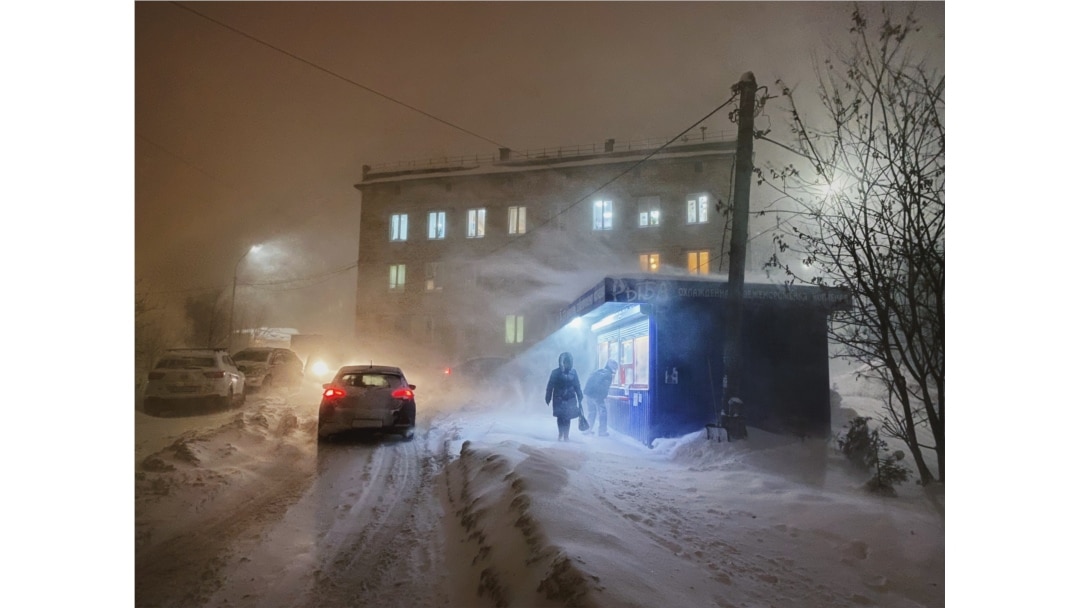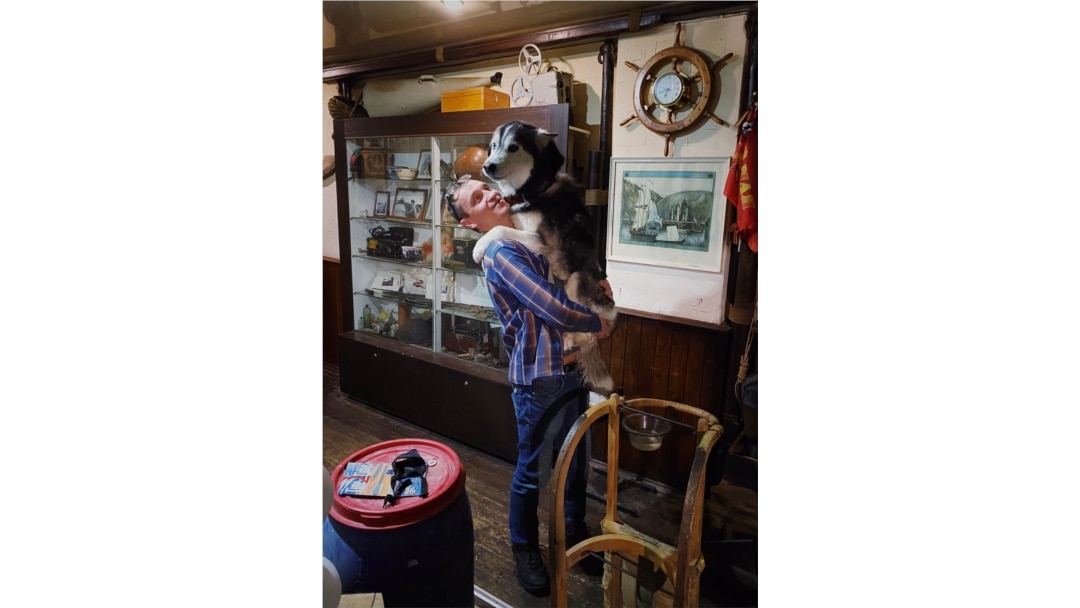
This is Murmansk, the largest city in the Arctic Circle. The picture was taken on December 11 at 11:32 a.m. as the sun neared its highest point just below the horizon.

A customer peers into a fish stall as a storm blasts through Murmansk at 3:25 p.m. Every year from December 2 until January 11 the Russian city endures the darkness of the polar night.

Ex-sailor Konstantin holds his favorite husky. The 52-year old says he loves Murmansk for the fishing and freedom the surrounding wilderness offers but that after living his whole life in the city he’s “a bit tired” of the winter dark.
A local man readies his gun at a Soviet-era shooting range in the city. Since 1989, Murmansk’s population has dropped from 468,000 people to just 292,000 now.
About 100 kilometers to the east of Murmansk, tsarist-era boats lie frozen in the moonlight late at night.
Murmansk was founded as Romanov-on-Murman in 1916, when Tsar Nicholas II sought an ice-free port that would allow war supplies to be shipped in from Russia’s allies.
Within months of the city’s founding, revolution swept the tsar from power and the city was renamed Murmansk.
In World War II, Murmansk again became vital for the U.S.S.R and its Western allies delivering materiel and aid for the Red Army. In 1941, Murmansk’s defenders held off attacks from German and Finnish forces, but the city was largely wiped out by Nazi air raids.
The hilltop Alyosha Monument of Murmansk dedicated to the Soviet servicemen who defended the city through World War II.
A Stalinist-era building stands in central Murmansk. Most buildings in the city date from the Soviet period, when a hectic era of reconstruction and the founding of a nearby naval base pushed the population of Murmansk to its peak of nearly half a million people.
Two men chat late at night in the courtyard of a Stalinist-era building. A taxi driver told RFE/RL that he slept “whenever he felt like it” during the weeks of winter darkness.
A nightclub in the city center on a Saturday night. Women make up about 54 percent of the city's population.
A woman waits for her bus in the warmth of a pharmacy at 2 p.m.
Local women during a service in the Church of the Savior on the Waters.
The Murmansk rail yard runs nonstop, mainly transporting coal. The rail freight industry is one of the few major employers left in the city after the fishing industry was decimated due to Western economic sanctions and tangled Russian customs rules.
Men drinking underground in a basement bar where a large glass of beer costs around $1.
A shopkeeper pours for a man who said the 10 liters of beer were for “my wife and me over the weekend."
A memorial to the sailors who died in peacetime. It was photographed at midday.
The northern lights glow late at night above a cemetery in the coastal village of Teriberka. Sights like this are driving one booming industry in the region.
A Chinese woman on the shore of the Barents Sea at midday. Since 2014, when Russia’s ruble plunged in value, local tour guide Mihail Tochilov says Chinese tourism to the Murmansk Oblast has spiked dramatically.
A hotel under construction at 2:40 p.m. under spotlights that allow the builders to complete a normal workday. In 2018, 64,000 foreign tourists -- most of them from China -- visited Murmansk to glimpse the northern lights. That's up from just some 200 Chinese tourists in 2013.
Friends from Guangdong, China, pose in front of a tsarist-era boat in Teriberka at 11:34 a.m. When RFE/RL asked this young woman why she had chosen Russia’s Arctic over nearby Norway or Finland, she replied immediately, “Cheap!” She then hooked her fingers together to say “and the two countries [Russia and China] are good friends.”
A friendly husky wandering the streets of Teriberka in the gloom of early afternoon. All pictures in this gallery were shot with an iPhone 11 Pro with the “night mode” enabled to allow handheld photography in the dark.
A Soviet-era interceptor is lit by the glow of Murmansk’s streetlights at 5:33 p.m. In the 1990s, Russian scientists deployed a giant mirror in space to test the feasibility of bouncing sunlight back down to Earth to illuminate Arctic towns like Murmansk.
A moonlit night in Teriberka. Although the initial experiment to put an "artificial moon" into orbit was a success, a second prototype suffered a mishap and, amidst the economic chaos of the late 1990s in Russia, the project had to be abandoned.
A mascot dressed as chicken and french fries in one of several giant shopping centers in Murmansk where locals go for brightly lit shopping.
A man walks through a blizzard in central Murmansk at 2:49 p.m. Most young people RFE/RL spoke to said they didn’t mind the winter, when northern lights sparkle in the sky and snow covers the ground. One hotel receptionist said, “Anyway, summer only really lasts a week or two and the winter is beautiful here. I prefer it.”


